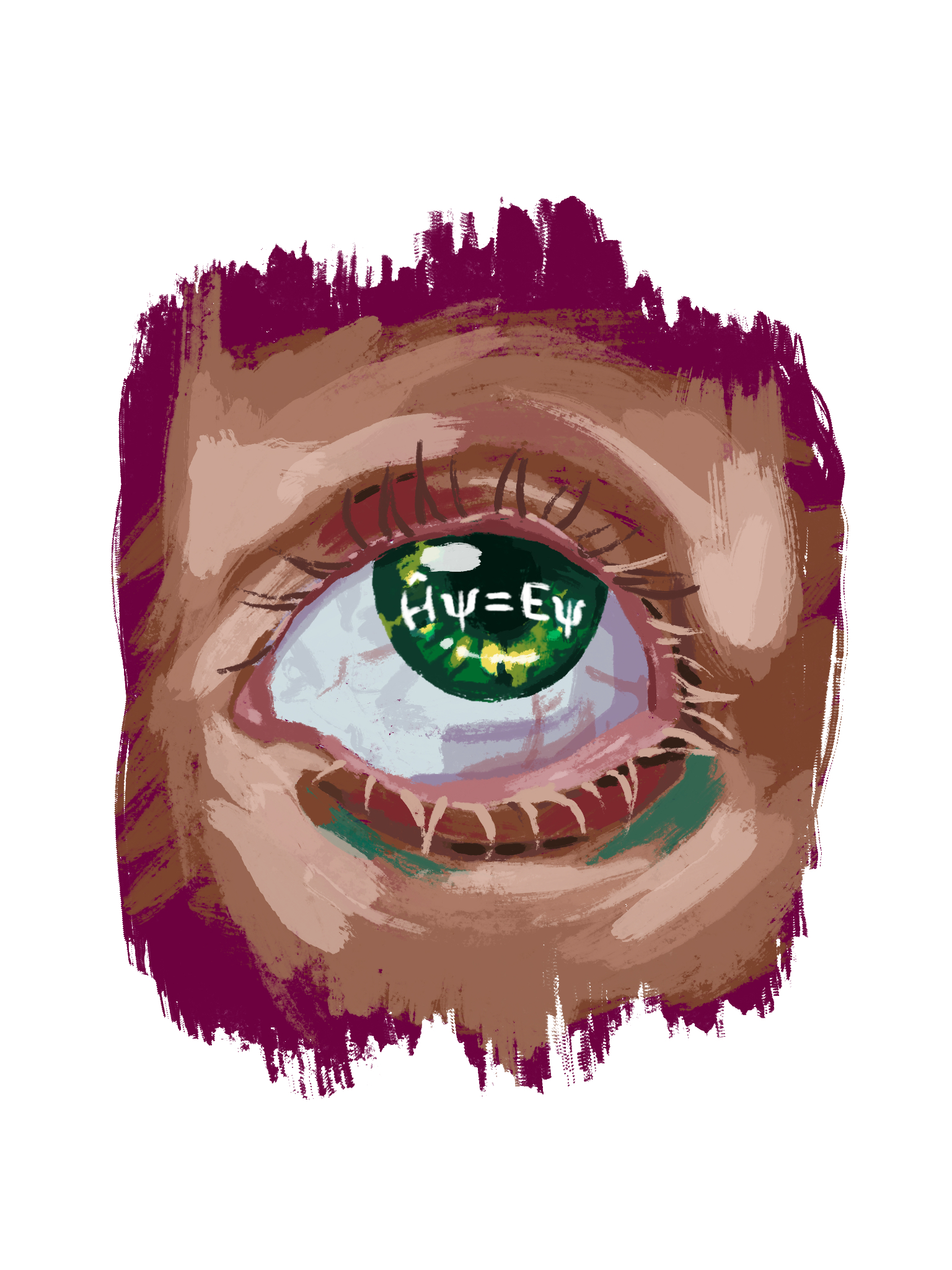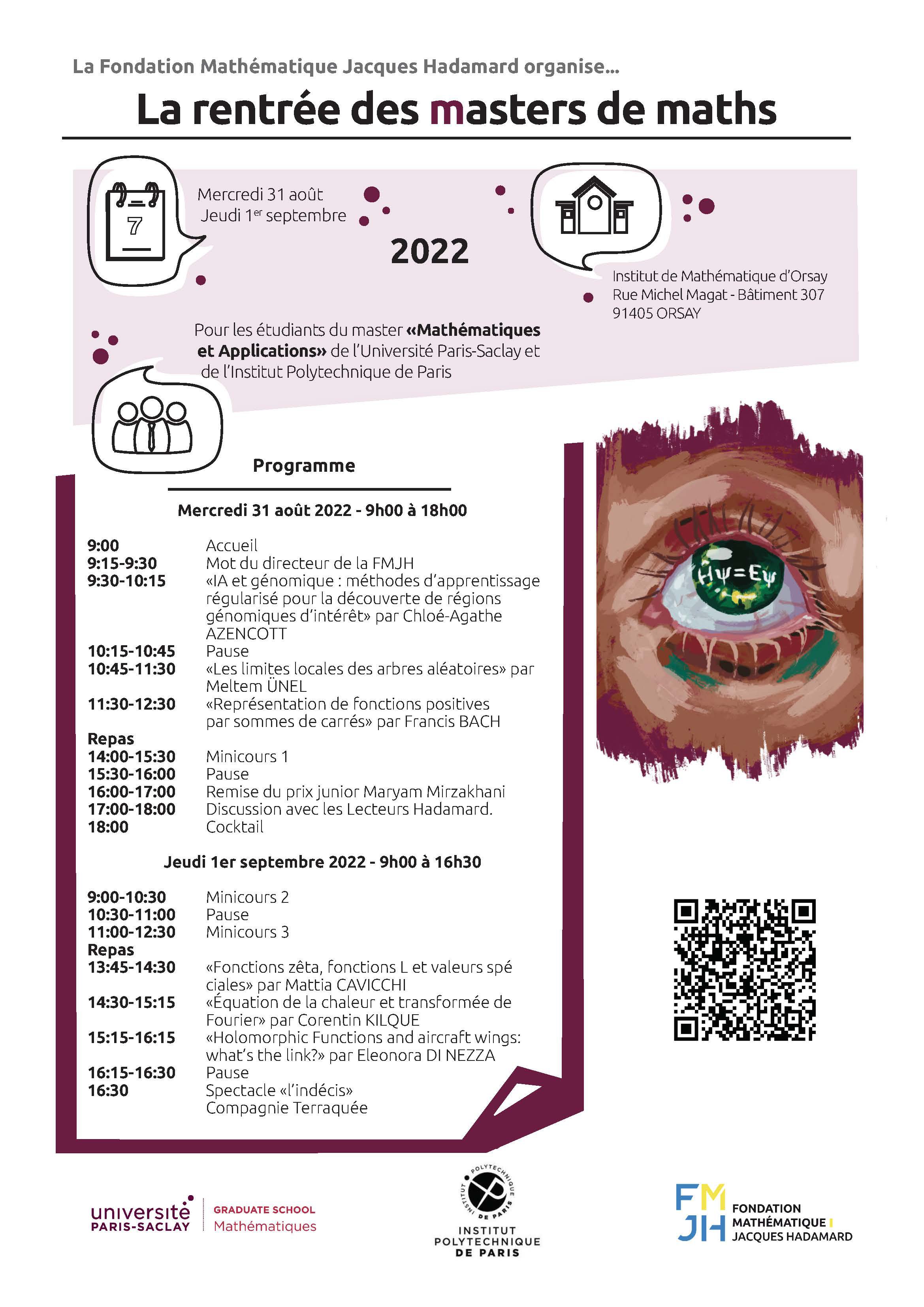
Master Starter 2022
On Wednesday August 31 and Thursday September 1, 2022 will take place the back-to-school of the Master's program "Mathematics and Applications" of the Université Paris-Saclay and the Institut Polytechnique de Paris at the Institut de Mathématique d'Orsay.
For students in M1 and M2 Jacques Hadamard Track and FMJH scholarship holders, attendance is compulsory.
Pre-registration is mandatory. An email confirming your registration will be sent to you in the 2 weeks preceding the event.
We inform you that the event "Rentrée des Master 2022" will be filmed and random photos will be taken during the 2 days. For any further information, you can contact us : contact@fondation-hadamard.fr.
Slides & Videos
Find the available presentations of the interventions which took place during the 2 days of Master starter.
- AZENCOTT Chloé-Agathe "IA et génomique : méthodes d'apprentissage régularisé pour la découverte de régions génomiques d'intérêt" Slide
- BACH Francis "Représentation de fonctions positives par sommes de carrés" Slide
- CAVICCHI Mattia "Fonctions zêta, fonctions L et valeurs spéciales" Slide
- HE Jiao Mini-cours "Autour des séries de Fourier et EDPs nonlinéaires" Slide
- KILQUE Corentin "Équation de la chaleur et transformée de Fourier" Slide
- ÜNEL Meltem "Les limites locales des arbres aléatoires" Slide
You can consult the available videos of the interventions on our Youtube channel

Mini-courses:
"Autour des séries de Fourier" by Jiao HE
Abstract: Fourier series is named in honor of Joseph Fourier, who made important contributions to the study of trigonometric series, after preliminary investigations by Euler, d’Alembert for the resolution of some physical problems: the vibrating string (wave equation), the thermal conduction (heat equation). Although Fourier’s original motivation was to solve the heat equation, its work later raised the deep mathematical problem of the convergence of the Fourier series and the resolution of this problem leads to remarkable development of the modern analysis. In my first lecture, I will present basic ideas about the Fourier series and its history of development.
In the second and third lecture, based on the Fourier series, I will first introduce some basic facts of Fourier analysis (Fourier transform), whose subject encompasses a vast spectrum of mathematics. Then, we will study the nonlinear Schrödinger equation, which is a universal equation that appears in the propagation of light in nonlinear optical fibers and also in the studies of water waves as well as other physical phenomenon. We will mainly study the nonlinear Schrödinger equation with special emphasis on the Cauchy problem, local and global in time and the long-time behavior of its solutions.
"An introduction to descriptive set theory" by François LE MAITRE
Abstract: Descriptive set theory is a branch of topology that focuses on subsets of a topological space which are somehow built from the topology. A good example of such subsets is provided by Borel subsets of the real line, and one of the aims of this minicourse will be to describe how these can be built inductively and nicely parametrized. Using Cantor's diagonal argument, we will also show that the hierarchy that arises naturally is strict and give various examples of natural Borel sets
whose exact complexity can be described. Most of the theory actually holds when the ambient topological space is Polish, i.e. separable and completely metrizable, and we will start with some general properties of such spaces, which abound in analysis. A key tool will be the fact that every uncountable Polish space contains a copy of the Cantor space, just like the reals do. Right beyond Borel subsets are analytic and co-analytic subsets, and if time permits we will also use tools
from descriptive set theory to give natural examples of (co)analytic non Borel sets, e.g. the set of pointwise converging sequences of continuous functions on the interval is co-analytic non Borel.
"Géométrie intégrale et racines de polynômes aléatoires" by Thomas LETENDRE
Abstract: Dans ce mini-cours on s'intéressera à des problèmes de géométrie intégrale, aussi appelée théorie des probabilités
géométriques. Notre premier objectif sera de démontrer la formule de Crofton, qui permet de calculer la longueur d'une courbe paramétrée dans l'espace euclidien comme le nombre moyen de points d'intersection entre cette courbe et un hyperplan affine choisi uniformément au hasard. Ce sera l'occasion de parler rapidement de mesures invariantes
et de géométrie affine. Dans un second temps, nous utiliserons une variante de la formule de Crofton pour calculer le nombre moyen de racines réelles d'un polynôme aléatoire à coefficients gaussiens.
Lectures:
"IA et génomique : méthodes d'apprentissage régularisé pour la découverte de régions génomiques d'intérêt" par Chloé-Agathe AZENCOTT
Abstract: L'intelligence artificielle est de plus en plus utilisée dans de nombreux domaines de recherche scientifique, y compris en génomique. L'exposé commencera par une brève introduction à l'intelligence artificielle et plus particulièrement à l'apprentissage supervisé, vu comme un problème d'optimisation. On se concentrera sur la sélection de variables en grande dimension, motivée par la recherche de régions du génome affectant une caractéristique précise (par exemple :
susceptibilité de développer une maladie donnée, réponse à un traitement). Je présenterai plus particulièrement quelques techniques de régularisation, qui consistent à contraindre le problème d'optimisation susmentionné.
"Local limits of random trees" par Meltem ÜNEL
Abstract: Trees or maps, when we deal with discrete objects, we are particularly interested in understanding the behavior of large ones. In this talk, I will try to introduce the ideas and some of the techniques involved in the construction of local limits of random trees by concentrating on the simplest case, namely the Uniform Infinite Planar Tree (UIPT). I will then conclude by briefly introducing more general setups, especially from my own research.
"Représentation de fonctions positives par sommes de carrés" par Francis BACH
Abstract: Beaucoup de problèmes de mathématiques appliquées peuvent être attaqués par une représentation numériquement efficace des fonctions positives, comme l’optimisation ou le contrôle optimal. L’utilisation de sommes de carrés permet une formulation à base de matrices ou d'opérateurs semi-définis positifs. Dans cet exposé, je montrerai comment les représentations classiques de dimension finie à base de polynômes peuvent être étendues à des espaces de Hilbert, tout en préservant leur efficacité numérique.
"Fonctions zêta, fonctions L et valeurs spéciales" par Mattia CAVICCHI
Abstract: La fonction zêta de Riemann est un objet analytique étudié depuis des siècles, lié de manière profonde à la distribution des nombres premiers. On sait aussi que ses valeurs aux entiers positifs, dites "valeurs spéciales", ont des propriétés arithmétiques remarquables. Toutefois, ses valeurs aux entiers positifs impairs restent encore mystérieux. Le but de l'exposé est de tracer synthétiquement l'histoire de l'étude de ces questions, depuis Euler jusqu'à nos jours, et de les placer à l'intérieur d'un vaste réseau de conjectures concernant des fonctions plus générales, dites fonctions zêta et fonctions L : un sujet au centre de la recherche mathématique actuelle entre analyse, théorie des nombres et géométrie algébrique.
"Équation de la chaleur et transformée de Fourier" par Corentin KILQUE
Abstract: La transformée de Fourier, qui transforme les dérivées en espace en des produits extérieurs polynomiaux en fréquence, permet de résoudre certaines équations aux dérivées partielles, d'ordinaire difficiles à résoudre explicitement, comme l'équation de la chaleur sur la droite réelle. Après des rappels d'analyse fonctionnelle sur la transformée de Fourier, on verra comment celle-ci permet de conduire la partie "analyse" de la résolution de l'équation de la chaleur dans un cadre fonctionnel régulier, c'est-à-dire obtenir l'unicité ainsi que la forme explicite de la potentielle solution forte. Cela nous permettra de faire apparaitre le "noyau de la chaleur", dont on illustrera enfin l'effet régularisant avec des simulations.
"Holomorphic Functions and aircraft wings: what’s the link?" par Eleonora DI NEZZA
Abstract: The problem of studying a fluid (irrotational and incompressible) flowing in a (simply connected) domain of the plane turns out to be equivalent to look for an harmonic function in the domain with some boundary properties.
Riemann’s Uniformization Theorem tells us that every simply connected domain in the plane (that is not the plane itself!) is biholomorphic to Poincaré's half plane H. It then suffices to study the behaviour of the fluid flowing in H and then to search for an holomorphic function between H and the initial given domain.
But now, what’s the holomorphic transformation between H and an aircraft wing?